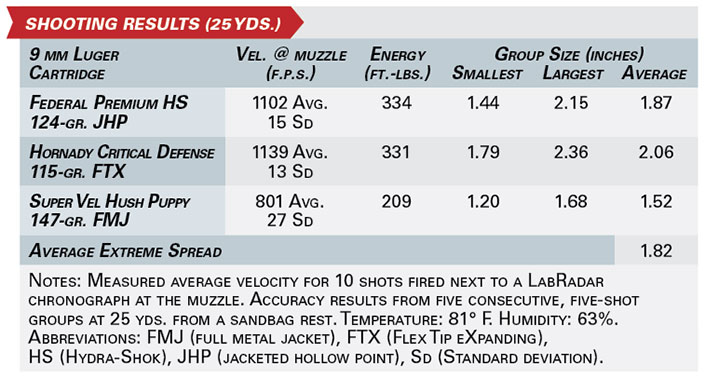
For decades, double-action semi-automatic pistols have fallen into two distinct categories: traditional double-action/single-action (DA/SA) and double-action-only (DAO). The virtues of each design are unique, as are their shortcomings. A recent entry that affords shooters the capabilities of both systems in one handy package is the Grand Power P11 in 9 mm Luger—a compact handgun whose method of operation can be selected with the sweep of a lever.
At first glance, the P11 appears to be just another polymer-frame, double-stack 9 mm, but a closer look reveals some unique and interesting features. The design has two elements that set it apart from other handguns in its class: a rotating-barrel locking system and the aforementioned safety lever. The bilateral levers, situated on the frame where the shooter’s thumb can easily reach them, perform several functions.

In its top-most position, the lever serves as a manual safety, locking the hammer to the rear when the handgun is in Condition One (i.e., when the hammer is cocked). When the lever is placed in the center position, the P11 functions just like any traditional DA/SA, exhibiting a long and relatively heavy double-action trigger pull that both cocks and releases the hammer, firing the handgun. The reciprocation of the slide then re-cocks the hammer, and subsequent single-action trigger pulls are both shorter and lighter. In its lowest position, the lever will de-cock the hammer if it is locked to the rear, and also places the pistol into double-action-only mode, where every shot requires a long-but-consistent pull of the trigger.
The P11 uses a polymer frame, built around a steel insert that interfaces with the working parts of the handgun. The slide’s rails are part of the steel insert. The recoil spring is flat and rides on a full-length guide rod that is captive to the frame. Beyond the multi-function safety lever, the P11 has bilateral magazine release buttons just behind the trigger guard, as well as bilateral slide locks—a shooter with average hands can reach all of the controls without shifting his or her grip on the pistol. The grip area of the frame is textured to enhance the gripping surface, and, though it is compact in length, it allows room for a full-fingered grip. An accessory rail on the dustcover provides a mounting point for lights, lasers or other accessories.
The slide is milled from a single steel block and has cocking serrations at both the front and rear. The vast majority of semi-automatic pistols on the market today use either a blowback or Browning-type locking mechanism, but the P11 uses neither. Instead, the 3.3" barrel is machined with an integral radial camming surface that causes the barrel to rotate clockwise in order to unlock the breech. When a round is fired, a ledge on the slide engages with the barrel cam, rotating the barrel as the slide moves to the rear. When the recoil spring forces the slide back forward, the barrel rotates back into battery. It is an innovative system that works well, but it is not completely novel; John Browning received a patent for a rotating-barrel design way back in 1897, and the idea has been used in other modern handguns, including the Beretta Px4.

Disassembly of the P11 is relatively simple as there are a minimal number of parts that are to be removed by the user. To fieldstrip the unloaded pistol, the takedown tab on the frame is pulled downward and the slide is drawn fully to the rear. The slide can then be lifted off the frame, rear end first. The barrel can be rotated forward and then lifted out of the slide, and the recoil spring then slides off the guide rod. No further disassembly is recommended by the manufacturer, and the gun is reassembled by reversing the process. It is important to note that the barrel must be unlocked and slid forward for correct reassembly.
The P11 is fit with a sturdy set of three-dot sights. The rear sight fits into a dovetail milled into the slide and, given its rounded shape, is unlikely to snag on clothing during a draw. A hex screw can be loosened with an included wrench that allows the sight to be drift-adjusted for windage. The front sight fits into a milled slot and is held in place by a roll pin. Two spare front sights of varying heights are included with the pistol so that any necessary elevation changes can be made by the end user.
We experienced some functional hiccups with our initial test pistol, but a replacement arrived quickly that functioned with 100 percent reliability. We were told by the P11’s importer that problems with this particular model are extremely rare and that our issue was not typical. Despite the innovative locking system and unique ability to transition between action styles, operation of the P11 was intuitive and straightforward.

Both the 12-lb. double-action trigger pull and the 4-lb. single-action pull were relatively smooth, with some minor creep evident on the latter. Single-action trigger reset was positive and of appropriate length during traditional DA/SA operation and was, of course, far longer in the DAO mode. With a six-o’clock hold on a 2" black square, our test pistol shot approximately 4" high at 25 yds. with each of the four different loads that we ran through the P11. This could easily be addressed by trading out the front sight for one of the included spares.
The P11 is a highly accurate, useful and interesting handgun that could easily serve as a combination home-protection and concealed-carry pistol. The ability to transition from DAO to DA/SA with the flip of a lever might make this the ideal handgun for an individual changing over from a revolver to a semi-automatic.




































